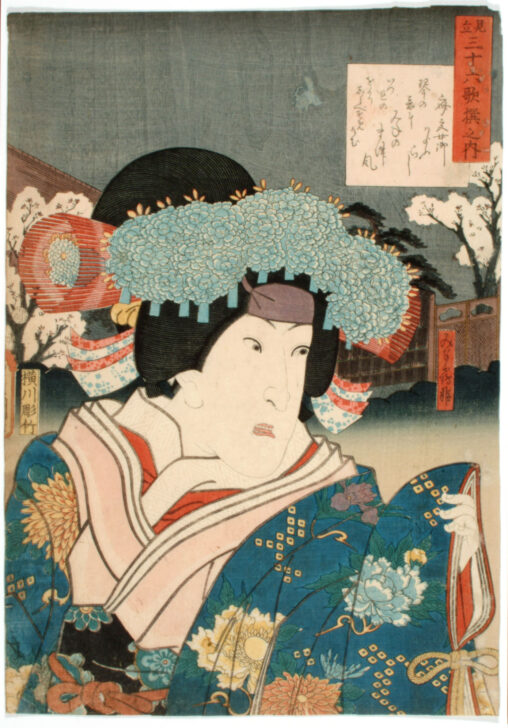Actors Compared with the Thirty-six Poet Immortals: Iwai Hanshirō VI as Princess Minazuru
Utagawa Kunisada

Description
In this series of prints, Toyokuni III (Kunisada) depicts popular kabuki actors against landscape backgrounds, and adds a cartouche with the name and a poem by one of the so-called "thirty-six poetic immortals," a selection of classical poets. The actors are identified only by the role and not by name, as actor prints had been forbidden in recent regulation. To a contemporary audience, of course, the actors would have been immediately recognizable by their physiognomies or actor's crests. Today, we can reconstruct the names of many, but not all, of the actors in the series.
Saigû Nyôgo, an imperial princess, is one of the "poetic immortals." Maizuru hime or Princes Maizuru is, in legend, the daughter of a monk at Kurama Temple who fell in love with the young Minamoto Yoshitsune when he was entrusted to the monk's care as a young boy. She stole a book on military strategy to give to Yoshitsune, for which she was set adrift in a boat and condemned to exile. After an exhausting journey, she came ashore and gave birth to Yoshitsune's child, but died not long thereafter.
The entire series is illustrated online at http://62.238.34.70/toshidama/prints.stm
Subject Matter:
The Thirty-Six Poet Immortals are a selection of classical poets known for their skills. The sellection is from the Heian period (794-1185) or earlier. This print juxtaposes Minazuruhime with Saigū no Nyōgo, a tenth century poet who became consort to Emperor Murakami (926-967, r. 946-967). Minazuruhime appears in the play Kiichi Hogen’s Book of Tactics (Kiichibōgen sanryaku no maki).
The artist, Utagawa Toyokuni III, was notable for creating images of actors in which specific individuals were identifiable. Not only were these popular actors recognizably depicted for fan consumption through these prints, but they were associated both with the poet immortals and specific flowers, each of which had special meanings in Edo society. Such layered meanings are hallmarks of mitate (literally meaning look and compare) prints. Mitate images were usually indicated by the use of the word mitate in the title, though it sometimes was omitted and viewers were meant to puzzle it out. This genre often juxtaposed contemporary figures such as kabuki actors with historical figures such as the poet immortals. Edoites enjoyed these layered meanings and would have made the connection between this series and the poet immortals with relative ease.
Actor Iwai Hanshirō VI was born in 1799 to father Iwai Tojaku I (Iwai Hanshirō V). He was active from the time he was a child, in 1804, until his death in 1836. This print probably recreates one of his performances as Princess Minazuru.
Physical Description:
In this print, a woman wearing several layers of robes looks over her left shoulder. Her left hand is partially raised. Her outer robe is a dark blue with brightly colored flowers that match her elaborate hair ornaments. The sky is dark behind her, and the roof and gates of a building are visible.
Inscriptions: Mitate sanjūrokkasen no uchi; Minazuruhime; Yokogawa Horitake (Carver's seal); (Artist's signature: cut off); Watanabe (Censor's seal)
Usage Rights:
If you are interested in using an image for a publication, please visit https://umma.umich.edu/request-image/ for more information and to fill out the online Image Rights and Reproductions Request Form.